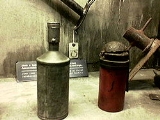
Filipinka
Encyclopedia
Filipinka was an unofficial, yet common name for the ET wz. 40 hand grenade
produced for the Armia Krajowa
during World War II
in occupied Poland.
It was designed by a former worker of the Rembertów
Polish Army munition works, Edward Tymoszak (hence the ET abbreviation). It was partially based on his pre-war design of a ET wz. 38 anti-tank grenade.
The Filipinka was an offensive impact grenade, cylindrical in shape. In the upper part of the shell a screw for the fuse was located. Coating of the first series (roughly 4,000 produced) was made of Bakelite, which shattered without producing fragments like a metal-bodied grenade. Later the shell was replaced with a metal impress. The filling was composed mostly of home-made explosives, either cheddite
or ammonal
. At times explosives from German air bombs and artillery shells, as well as British plastic explosive
delivered through air bridge
s was used. The grenade was equipped with a contact fuze
which functioned on impact with the target.
The coating was painted with various colours to allow for easier usage in resistance service and easier hiding. After 1941 all grenades were marked with an inscription in Russian
(Desantnaya Udarnaya Granata 41 - Paratroopers' Impact Grenade Mark 41) in order to conceal the real origin of the weapon and ensure the safety of the production facilities. Throughout the war approximately 240,000 grenades of this type were produced. Many of them were used in various battles of the Operation Tempest
, including the Warsaw Uprising
.
Hand grenade
A hand grenade is any small bomb that can be thrown by hand. Hand grenades are classified into three categories, explosive grenades, chemical and gas grenades. Explosive grenades are the most commonly used in modern warfare, and are designed to detonate after impact or after a set amount of time...
produced for the Armia Krajowa
Armia Krajowa
The Armia Krajowa , or Home Army, was the dominant Polish resistance movement in World War II German-occupied Poland. It was formed in February 1942 from the Związek Walki Zbrojnej . Over the next two years, it absorbed most other Polish underground forces...
during World War II
World War II
World War II, or the Second World War , was a global conflict lasting from 1939 to 1945, involving most of the world's nations—including all of the great powers—eventually forming two opposing military alliances: the Allies and the Axis...
in occupied Poland.
It was designed by a former worker of the Rembertów
Rembertów
Rembertów is a district of the city of Warsaw, the capital of Poland. Between 1939 and 1957 Rembertów was a separate town, after which it was incorporated as part of the borough of Praga Południe. Between 1994 and 2002 it formed a separate commune of Warszawa-Rembertów...
Polish Army munition works, Edward Tymoszak (hence the ET abbreviation). It was partially based on his pre-war design of a ET wz. 38 anti-tank grenade.
The Filipinka was an offensive impact grenade, cylindrical in shape. In the upper part of the shell a screw for the fuse was located. Coating of the first series (roughly 4,000 produced) was made of Bakelite, which shattered without producing fragments like a metal-bodied grenade. Later the shell was replaced with a metal impress. The filling was composed mostly of home-made explosives, either cheddite
Cheddite
Cheddite is a class of explosive materials that were originally manufactured in the town of Chedde in Haute-Savoie, France in the early twentieth century. Closely related to Sprengel explosives, cheddites consisted of a high proportion of inorganic chlorates mixed with nitroaromatics Cheddite is a...
or ammonal
Ammonal
Ammonal is an explosive made up of ammonium nitrate, trinitrotoluene , and aluminium powder.The ammonium nitrate functions as an oxidizer and aluminium as a power enhancer. To some extent the aluminium makes it more sensitive to detonation...
. At times explosives from German air bombs and artillery shells, as well as British plastic explosive
Plastic explosive
Plastic explosive is a specialised form of explosive material. It is a soft and hand moldable solid material. Plastic explosives are properly known as putty explosives within the field of explosives engineering....
delivered through air bridge
Airbridge (logistics)
An airbridge is the route and means of delivering material from one place to another by an airlift.An airbridge is the means by which an airhead is kept supplied by overflying enemy held territory...
s was used. The grenade was equipped with a contact fuze
Fuze
Fuze Beverage, commercially referred to as just Fuze , is a manufacturer of teas and non-carbonated fruit drinks enriched with vitamins. Currently the brand consists of five vitamin-infused lines: Slenderize, Refresh, Tea, Defensify, and Vitalize...
which functioned on impact with the target.
The coating was painted with various colours to allow for easier usage in resistance service and easier hiding. After 1941 all grenades were marked with an inscription in Russian
Russian language
Russian is a Slavic language used primarily in Russia, Belarus, Uzbekistan, Kazakhstan, Tajikistan and Kyrgyzstan. It is an unofficial but widely spoken language in Ukraine, Moldova, Latvia, Turkmenistan and Estonia and, to a lesser extent, the other countries that were once constituent republics...
(Desantnaya Udarnaya Granata 41 - Paratroopers' Impact Grenade Mark 41) in order to conceal the real origin of the weapon and ensure the safety of the production facilities. Throughout the war approximately 240,000 grenades of this type were produced. Many of them were used in various battles of the Operation Tempest
Operation Tempest
Operation Tempest was a series of uprisings conducted during World War II by the Polish Home Army , the dominant force in the Polish resistance....
, including the Warsaw Uprising
Warsaw Uprising
The Warsaw Uprising was a major World War II operation by the Polish resistance Home Army , to liberate Warsaw from Nazi Germany. The rebellion was timed to coincide with the Soviet Union's Red Army approaching the eastern suburbs of the city and the retreat of German forces...
.

